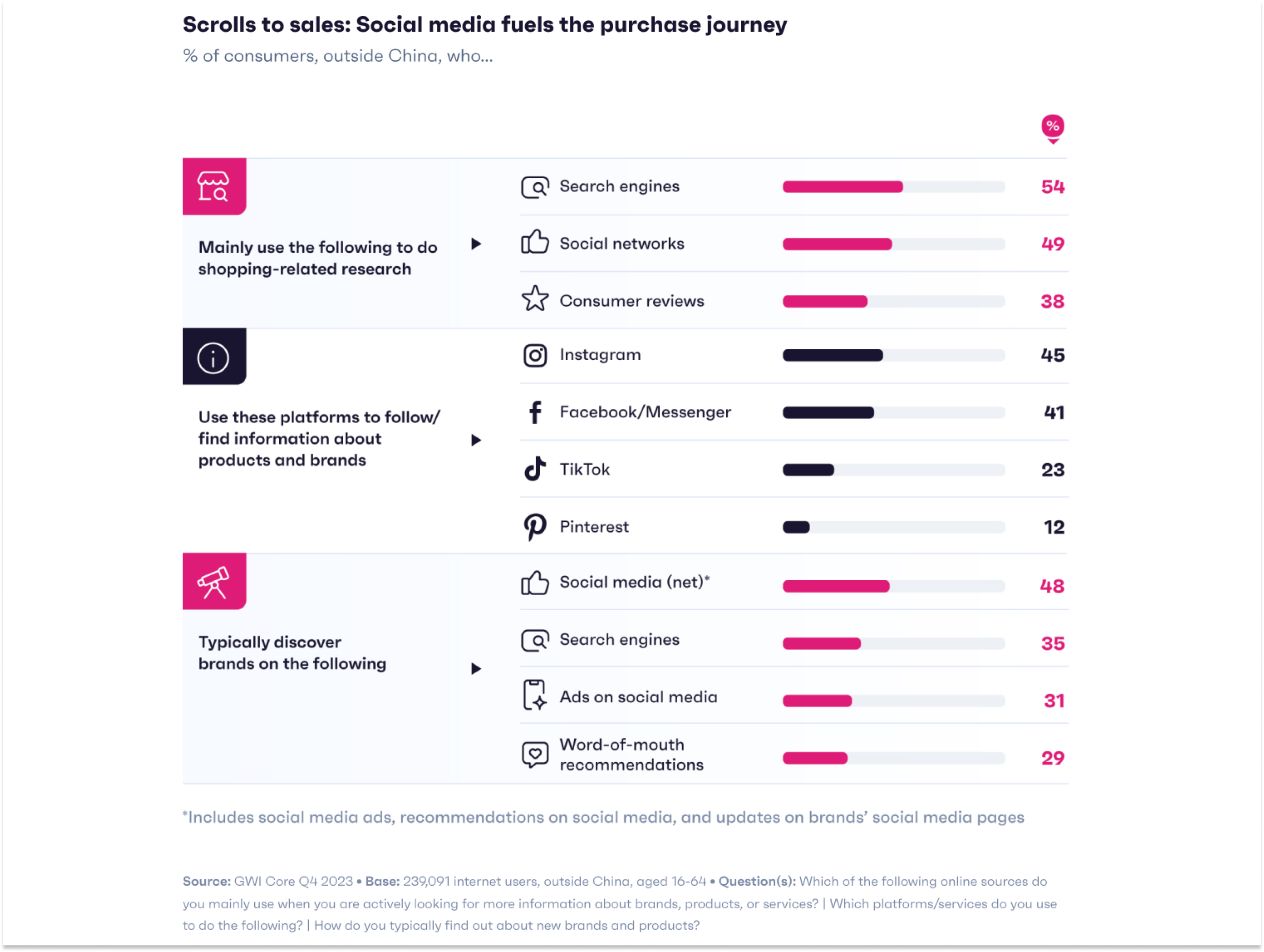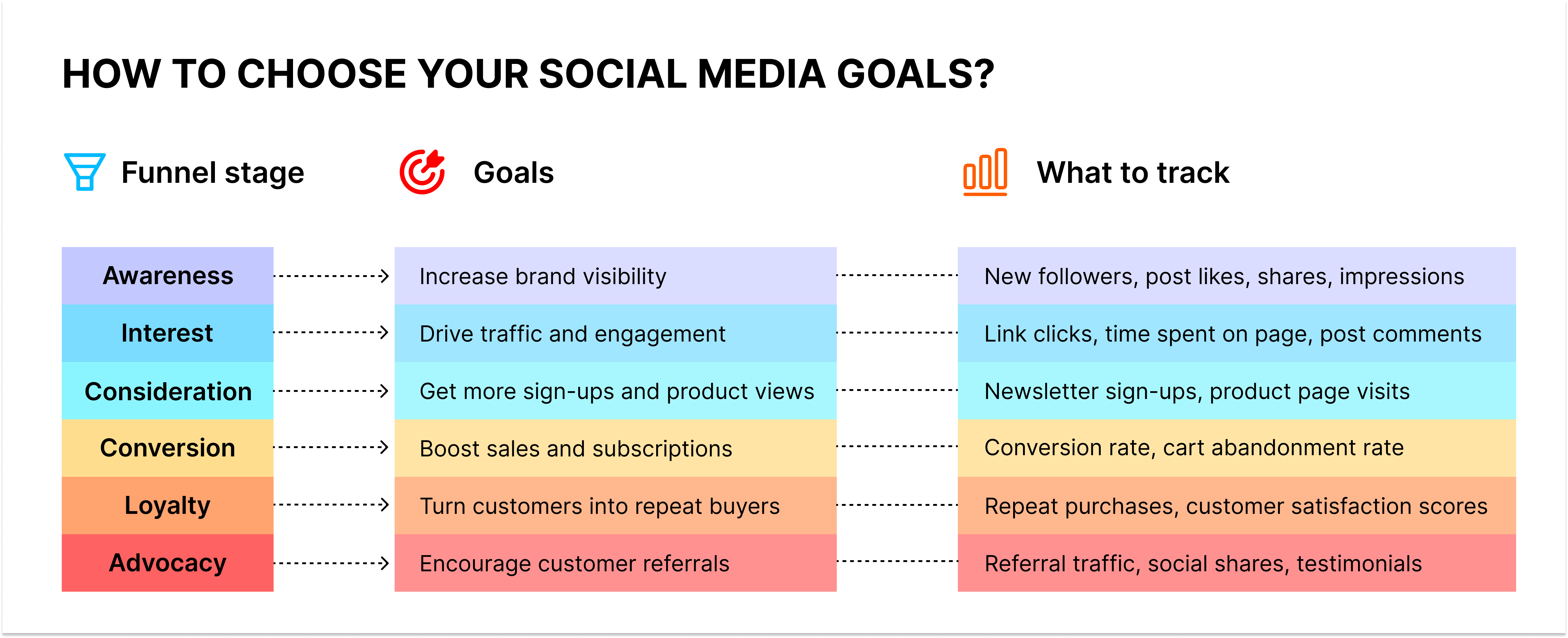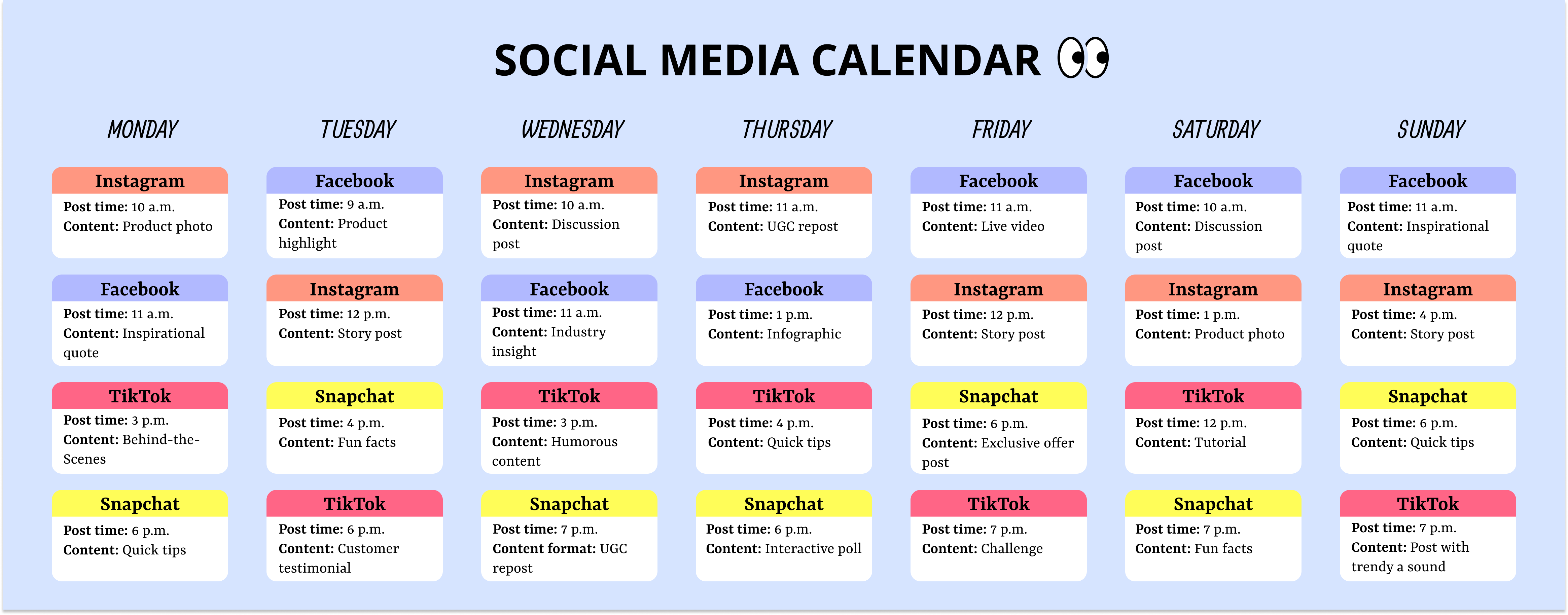Small Business Marketing: How to Leverage Social Media for Growth
2024-08-03

These days, social media is a great way for small businesses to reach and connect with customers.
Platforms like Facebook, Instagram,TikTok, X, and others let businesses talk directly to their audience, build strong relationships, and increase sales. Using social media well can really change how small businesses market themselves, making it easier and cheaper to reach thousands of people.
In this article, we’ll talk about how you can benefit from using social media for your small business and how to do it effectively to get not just noticed, but remembered and recognized as well.
Why your small business needs social media
When the new medium arrives and takes over, money follows: it happened when TV became popular and partially replaced paper and outside advertising, then when everyone went online and started using the Internet, and now the same is happening with social media.
Almost every business out there runs a Facebook or Instagram page, posts TikToks, and chats with their customers on X, and there’s a number of good reasons for doing so.
Here’s what social media allows you to do:
1. Connect with your customers
The great thing about social media is that it lets you talk directly with your customers. Social media platforms also work faster than email or chatbots, which lets you listen to what your customers say, answer their questions, solve their problems, get feedback, and chat with them in real time.
Speed, coupled with a personal approach, helps you stand out and create stronger connections with your customers.
2. Make your business more visible
Statistics show that people spend hours every day on social media, not just a few minutes. This means your business needs to be there too, if you want more people to know about it. Most of your potential customers will see your brand's Facebook or Instagram page way before they ever visit your website.
If you’ve got a young audience, keep in mind that they tend to use social media like a search engine. They look up products and services there, which means they’re likely to discover your business this way.
Also, having people talk about your business on social media can work like a charm for promotion: the more talk there is, the more visibility you’ll get. If you build a coherent and unique brand image and put it out there, be sure that you’ll be remembered.
All of this makes social media a powerful tool for getting noticed and growing your audience.
3. Show your products and services
Let’s be clear here: social media is mostly about the visuals now – images, videos, and so on.
Visuals are an excellent way to show why people should buy your products: you can share customer testimonials, how-to videos, and more. This is way more engaging than just static photos or old-fashioned product descriptions because you can actively show your products and services to your audience, not just tell about them.

Customer journeys start on social media: that's where you want to be to drive more people through your conversion funnel. Source: GWI
Also, good visuals, especially when they're more than just advertisements, are way more memorable than any text can be.
4. Get insights about customers and competitors
Last but not least, social media is a goldmine for doing quality research not just on your target audience, but on your competitors as well.
You can check what kind of content your customers enjoy, when they’re most active, how they interact with your posts, and a lot more.
You can also use social media to see what your competitors are doing: spot trends they participate in, see what’s working for them and how they attract new followers, learn from their mistakes, etc.
And the best thing is that it’s a lot cheaper than other methods of research. You don’t have to conduct surveys or interviews separately – you can simply observe how people and other businesses behave in this digital habitat.
With these insights, you’ll be able to adjust your marketing strategy for better results, improve your products, and take your well-deserved spot within your niche.
All of that being said, you might still have your doubts about venturing out there in the world of social media. It is no secret that big brands have a lot more resources to pour into social media marketing, and often they are also more visible than smaller businesses. That’s why it might seem that large budgets and dedicated social media departments are the only ways to make your name out there.
However, this is nothing but a stereotype. No matter how big your business and your budgets are, you can gain traction on social media if you use the right strategies.
But first, you need to understand what you want to achieve on social media.
How to set the right social media goals
Without clearly defined goals, it’s hard to measure the results of your efforts and judge whether your strategy is working for you or not.
Here are the steps you can take to set the right goals for your social media presence:
Think about the broader context
First things first, answer this question: why does your business need to be on social media?
Maybe you want more people to know about your brand, get more sales, improve customer relationships, or maybe it’s entirely something else – the answer will determine your strategy, so think it through.
When setting your goals, it’s helpful to consider your conversion funnel, which represents the stages your customers go through before making a purchase.
There are plenty of different funnel models that you can find online, but we find this one the most clear and straightforward:
- Awareness: at the top of the funnel, potential customers become aware of your brand. Your goal here might be to increase visibility and reach more people through sharing engaging posts, running ads, and partnering with influencers;
- Interest: at this stage, potential customers show interest in your products or services. Your goals might include driving traffic to your website or getting people to engage with interesting and educational content;
- Consideration: here, potential customers are considering whether to buy from you. Your goals might look like encouraging sign-ups for newsletters, getting users to follow your product updates, participate in your webinars or demos, and so on;
- Conversion: this is where potential customers make a purchase. You might want to increase sales and AOV, reduce cart abandonment rates, etc.;
- Loyalty: after the purchase, your main goal is to turn customers into repeat and loyal buyers through promoting loyalty programs, encouraging user-generated content, getting feedback from customers to improve your products and relationships with them, and so on;
- Advocacy: the final stage is when people become not just customers but advocates for your brand, spreading the word to others. In a way, this is a final goal that you can set once you reach all of the previous goals.
Understanding all of the stages of your sales funnel and where your social media activity fits in is key to setting the right goals to pursue.
Know your audience
To deeply understand the whole journey your customers make all the way up to conversion, you need to know them well. This includes various characteristics, needs, interests, and other details they share in common, which hopefully, you’re already aware of.
But besides this, you need to learn how they use social media and where they spend most of their time.
Are they more into Instagram or TikTok? Do they prefer watching videos or looking at photos? Do they like long-form content or posts that take just a few seconds to check out? How do they engage with brands on social media (if they engage at all)?
Understanding this will help you create content they’ll love and interact with them in a way that can build a solid relationship with your business.
For example, if you’ve researched your core audience and figured out that they’re mostly young and prefer TikTok over other platforms, you want to focus on creating fun and short videos as a part of your social media strategy. If your audience is older, more professional, and spends a lot of time on LinkedIn, you can focus on sharing industry news and insightful articles there.
Tie your goals to your overall marketing efforts
Your social media goals should also fit in with your overall marketing plan if you want to get the best results. So, think about how social media can help your marketing campaigns elsewhere.
For example, if you’re launching a new product, you can use social media to build excitement with teaser posts, behind-the-scenes content, livestreams, etc. If you’ve got a sale or a special promotion going on, announce it on social media through engaging posts and prompt people to create UGC to share their experience with your products (you can reward the best creators with bigger discounts and gifts).
Basically, no matter what kind of marketing campaigns you’re currently running, you can always enhance them with the help of social media. For a consistent brand experience, make sure your social media content matches the tone and style of your email newsletters, website content, and other materials.
Choose KPIs to track
Once you’re clear on the goals you want to achieve, decide which metrics and KPIs to track – that’s how you measure the effectiveness of your campaigns.
For example, if you’ve decided that your main goal is to make more people to know about your brand, track metrics like new followers, likes, and comments. If you’re targeting the interest stage of your funnel and want more leads, check how many people click your links and visit your website.

When setting goals for your social media activity and choosing metrics to track, make sure they fit the type of campaign you're running based on the sales funnel stage.
Also, when you’re picking your KPIs, make sure your goals are SMART: Specific, Measurable, Achievable, Relevant, and Time-bound. If your goals don’t match all of these characteristics, rethink them: otherwise, you might waste time and effort on unclear and unachievable tasks, making it hard to see progress or succeed.
Metrics and KPIs can help you determine if your goals are SMART or not. Here are a few examples of correctly set goals:
- If you want to increase brand awareness, aim to gain 500 new followers on Instagram in the next three months;
- If you want to generate more leads, try to increase website traffic from social media by 20% in the next quarter;
- If you want to boost engagement, set a goal to double the number of comments on your Facebook posts over the next six months;
- If you want to improve customer loyalty, aim to increase repeat purchases by 15% within a year by engaging customers through social media.
Sounds pretty achievable, time-bound, and measurable, right? This is exactly how you want your goals to be to move into the right direction and avoid the frustration of not achieving the vague results you were hoping for.
Now that you know what your goals are, let’s check out the best practices for using social media effectively to reach them.
How to use social media for small business effectively
1. Build connection
If you fail to connect with your audience on social media at a meaningful level, you won’t see significant results from your efforts. Creating a real connection with your audience is key to making your brand stand out and building lasting relationships.
It’s not easy to do by any means: social media is oversaturated as it is, so you have to deeply understand your audience and their changing needs to create content that will get more than just impressions.
Here’s how to do it:
Show the human side of your brand
One of the best strategies is to let your audience see the real people behind your brand. Instead of posting generic stuff, show off the everyday moments of your team and give your audience a peek into your world.
You can film Behind-the-Scenes videos to show your team in action: how they’re brainstorming new ideas, packing orders, working on creating the items, or even simply chilling during their breaks.
With virtual workspace tours , you can also take your followers on a fun tour of your office or workspace and let them see where the magic happens. It’s like giving your audience a backstage pass, and it helps you build deeper personal connections between them and your business.
Celebrate milestones together
Arguably, nothing binds us together better than celebrating important milestones in our lives: birthdays, anniversaries, achievements, etc. But businesses and the people behind them have milestones, too, so celebrate them and share these moments with your audience.
You can use milestone celebration posts where you talk about your achievements. Think of it as throwing a virtual party – everyone loves a good celebration, so include your audience in it as well.
Another way to celebrate together is to host virtual events to mark the occasion. Invite your followers to join in and participate, but make sure that it’s going to be fun for them.
Celebrating milestones on social media is a great way to make your followers feel like part of your journey and connect with you better.
Introduce your team
Introducing your team to your audience is another method of making your business more “human” and approachable.
To help your audience get to know the amazing people who make your business work, try team introduction posts and meet the staff videos.
You can post photo and video content with interesting tidbits about your team members to let your customers see who’s responsible for fulfilling their needs. Who’s the best prankster in your office? Who makes the best coffee? Who knows all the latest TikTok trends?
Sharing these small details can help your audience see your business not just as a profit-making entity, but as a community of people like them.
Share your story
Good stories also create points of connection between brands and people, so make storytelling a major part of your social media strategy if you want to see good results.
You can share the journey of how your business started, the ups and downs, and what keeps you going to make your brand more relatable and memorable. One of the content formats that can help you with that is the founder's story posts: they let you tell about your business’s beginnings and your journey.
You can share with your customers when, why, and how you’ve decided to do what you’re doing, what drove you to it (e.g. specific values that shape your brand), and so on. It’s like sharing a highlight reel of your business’s life: if you also add in some funny or inspiring moments to it, you’ll make it a lot more engaging than a regular timeline post could ever be.
Engage authentically
If you want to build really stable relationships with your audience, it’s crucial to not only post content, but also to engage with them: respond to comments and messages, notice the content they create with mentions of your brand, interact with posts of other creators and brands, etc.
But remember that you have to be genuine for it to work. Instead of using automatic replies, take a moment to craft personalized responses – this way, you’ll show you care and value your customers’ inputs.
You can also host Live Q&A sessions to answer questions from your audience. It’s a great way to show off your expertise, connect in real time, and, more importantly, provide the necessary information about your products: how and when to use them, who they are made for, what makes them better than other options on the market, and so on.
Show appreciation to your customers
Besides putting your business in the spotlight, you also want to give attention to your customers – after all, they’re the most important, right?
You can go a step further and not simply interact with your customers, but also highlight their stories and their experiences with your products or services. It will show that you value them and help others see the real-life benefits of what you offer.
Posting customer testimonials and sharing user-generated content will help you do this. Simple Thank-you posts are also a good way to let your customers know you appreciate them.
Be transparent
Being open about your business practices and any hiccups along the way also builds trust. So, if things don’t go perfectly, be honest about it and explain how you’re fixing it.
Share updates on business practices or challenges you’re facing in transparency posts. It’s like pulling back the curtain and showing how things really work, which assures your customers that no matter what happens with your business (even if it encounters some problems), they’ll be aware of it.
By explaining how you’re addressing any issues that arise, you’re also showing that you’re on top of things and committed to making things right. This transparency builds trust between your business and your audience, and that is worth something.
Be a part of the conversation
Joining in on relevant discussions and trends in your industry helps you position your brand as knowledgeable and approachable. Brand reputation matters a lot these days, and showing your expertise is one of the ways to build it.
You can share news or insights related to your field through industry update posts and start or join conversations through discussion posts on trending topics.
Engaging with the lighthearted social media content of other brands and creators can also be very useful: it makes your business come across as more down-to-earth, humorous, and aware of current trends. But it’s important to not overdo it and make sure that what you engage with and how you do it match your brand’s personality and the interests of your audience.
By using these tips, you'll connect better with your audience on a personal level. People will feel more connected to your brand, turning casual followers into loyal customers. As your customers become more engaged, you'll see real results from your social media efforts. Your posts will get more likes, comments, and shares, and your brand will become a favorite spot for your audience. Plus, a loyal customer base can lead to more word-of-mouth referrals, which will help your business grow even more.
2. Provide value
If you want your social media to really shine, don’t just use it to make people aware of your products or services.
Your primary goal should be to provide value to your audience. Who knows, maybe your brand’s page or account can become a favorite go-to resource to some people? By sharing useful and fun content, you’ll turn your social media into a place people love to visit.
Here are the content formats you can use to make that happen:
How-to guides and tutorials
More likely than not, your followers and other people on your social media platform of choice experience some kind of problem.
It doesn’t matter whether these problems happen regularly or not, whether they are major and require a lot of effort to solve, or minor and quickly fixable, etc. The main thing is that you can identify these problems, address them, and offer possible solutions.
Nothing is better for this than how-to guides and step-by-step tutorials that make life a little easier. For example, if you’re running a small bakery, you could post a video showing how to whip up a quick and delicious dessert to satisfy an occasional craving.
And, what also matters here, you can casually introduce your audience to specific products you make. For example, show how to use the bagels or buns you bake to create original dishes at home – that’s how you combine useful information with promotion in one post.
Infographics
Let’s be honest: sometimes information can be a bit overwhelming, even if that’s exactly what your audience is looking for. That’s where visuals can be especially useful - they are perfect for turning complex stuff into something you can actually understand without needing to be an expert.
For example, if you have a skincare business, you can create an infographic showing how different ingredients interact with each other in your products, which combinations help with various issues, and so on.
No matter what type of business you’re running, there’s always a way to explain something to your customers, share a bit of important information with them, etc.
Infographics is an excellent content format for this, and it also doesn't have to be boring: you can create static infographics with aesthetic visuals that simplify tricky concepts, or add a little flair with short animations that make the information more engaging.
Frequently Asked Questions (FAQs)
Good customer service is built on answering any questions your audience might have, and usually these questions repeat a lot.
That’s where you can save yourself some time and help your followers by answering those FAQs on social media. For example, if you run a pet store, you can create a post answering common questions like “What’s the best food for my cat?” and clearing prevalent misconceptions about the topic.
This type of content makes it easier both for you and for your potential and existing customers: you won’t have to answer the same questions over and over again, and your audience will quickly find the right information.
It’s a win-win scenario, and the best thing is that you can use different content formats for this: text posts, carousels, video Q&As, stories with interactive elements, etc.
Industry news
As we’ve said before, being a part of a conversation is really important if you want to stay relevant and build your reputation in an oversaturated social media environment.
And what’s the best way to do this, if not stay on top of industry news and trends? This helps you establish your business’ reputation as reliable and trustworthy, as well as keep your followers informed.
For example, if you run a business selling tech gadgets, share the latest releases or breakthroughs in the field with your audience – it’s like being their personal news anchor when it comes to your industry.
Here are some types of news posts you might want to try:
- News roundups: share summaries of the latest happenings in your industry in a blog post or social media update;
- Curated articles: post links to interesting reads with a bit of your own commentary;
- Video updates: create short videos discussing the most recent or noteworthy news.
Remember to always fact-check what you’re talking about and make it interesting for your audience. Even if it’s just a regular news update, you can always tell it in a way that will pique people’s interest.
Tips and Best Practices
Besides answering people’s questions, telling them how to do something, sharing information with them, etc., another good way to deliver value to your audience is to share practical advice and best practices with them.
Everyone loves a good tip, especially when it makes life easier. If you take time to get to know your audience better, you’ll know what they usually struggle or could use some help with. That’s where you can act as a mentor and give them something to try out.
For example, if you’re selling gardening supplies, post tips on how everyone, even the busiest and most forgettable, can keep their plants thriving. You can do it through simple text posts or videos – depends on what your audience prefers.
But when sharing best practices and tips, make sure that they’re actionable: your followers should be able to use them right away. So, keep it simple and doable, and you might get a lot of appreciative comments from your audience or even get viral (“lifehack” posts get popular quickly for a reason!).
Resource lists
Finally, we have lists: a content format that is universally used by everyone. And who doesn’t love a good list, especially when includes helpful resources?
If you want to be helpful to your audience, compile and share lists of resources they might need for a specific purpose. This can include products, tools, books, websites, apps, etc., that your followers might find useful.
For example, if you sell fitness equipment, share a list of exercises your followers can do at home when they don’t have time to go to the gym. You can share your listicles with text, images, carousels, videos, or even create downloadable PDFs (you can use them as download gates too!).
By providing this kind of content, you’ll make your social media pages a valuable resource that people actually want to visit. Not only will this help build a loyal following, but it’ll also make your brand stand out as helpful and genuine.
Plus, it’s a lot more fun and engaging than just posting endless promotional materials.
3. Be consistent
Even if you have some really excellent content to share, it won’t mean much without consistency: if you’re not posting regularly, it will be hard to be remembered.
Being dependable and showing up consistently lets your audience know that they can always rely on you to enjoy fun and entertaining or useful and informative content, get their questions answered, receive help, etc. It helps you build trust and keeps your followers interested.
Here’s how to stay on track:
Create a content calendar
Think of a content calendar as your social media plan: it helps you decide what to post and when, so you always have ideas ready.
To keep your social media feed interesting, make sure to mix up your content: share a variety of posts like videos, images, articles, polls, etc. Don’t get stuck on just one format – the variety will keep your audience engaged and make your page more fun to follow.

Your social media calendar can look very different from this one: the most important thing is to know what your audience loves to see and when.
Remember to plan for special days: mark your calendar for holidays, industry events, and company milestones. These occasions are perfect for creating timely and relevant posts that your followers can enjoy and connect with.
Also, don’t forget to regularly review your content calendar. Check what's working and what isn’t. If you notice some posts are more popular than others, try to understand why: maybe your audience prefers specific formats or topics, which means you can create more of such content.
Set up a posting schedule
Keeping a regular posting schedule is essential for staying on your audience’s radar. If you post at random times, people might forget about you.
To create an effective schedule, check your social media analytics to see when your audience is most active: this will help you pick the best times to post.
It's also important to find the right balance in how often you post. You don't want to overwhelm your followers with too many posts, but you also don't want to post so infrequently that they forget about you. There are a lot of tools for scheduling your posts out there, like Buffer or Hootsuite, so you can use them for convenience.
And don’t forget to keep an eye on how your posts are performing. Notice which times and days get the best response, and adjust your schedule to match – that’s how you get a higher reach and engagement on your posts.
Manage your community
Managing your community on social media is also super important for building a strong group of loyal customers: the more you interact with your audience, the more connected they'll feel to your brand.
To manage your community well, try to reply to comments and messages within a few hours to show you care. Encourage interaction by asking questions in your posts and getting your followers to share their thoughts. Highlight your followers by sharing their photos and reviews to show you appreciate them.
And remember to stay positive: handle negative comments calmly and professionally, offering solutions to any problems.
Staying proactive and engaged can significantly boost your ranking in social media algorithms, making it easier for people to see your posts. So, never underestimate the importance of community management.
Recap
When it comes to social media promotion, it doesn’t matter how big or small your business is: there are opportunities for everyone, but you have to be smart about it.
Connection, value, consistency, and flexibility – those are the main ingredients in the recipe for social media success. So, follow the tips we've shared in this article to get higher engagement on your posts and turn your followers into loyal customers.
Also, check out our articles about the ideas for small business marketing and best platforms for advertising if you're serious about promoting your business online.

